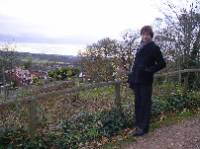Profile
Blog
Photos
Videos
National Trust Daytrip: Kinver Rock Houses
The term caveman conjures such a distinct image, a whole existence sporadically generates in our imagination of primal humans wearing some exotic animal's hide around their goods. Olive skin thick with grease and that unwashed shine patches of black dirt almost ingrained in their pores. We think of dank, musty and barren cave dwellings that reek of living odours. A billow of grey smoke snaking through a dark enigmatic hole in a clifface driving the stench of roasting carcass into our nostrils. We imagine a piece of hacked tree as a main tool, we imagine cold heartless living conditions, violent aggressive Neandathals.
Right.
Well lay that all aside. And imagine an ochre sandstone cliff, a rich red-brown cliff overlooking a quaint English town, with carved out holes in the walls sitting snugly in them are iron gridded windows their delicacy evident as the wind rattles the fittings of the small glass squares. Imagine a door stuck into a makeshift entrance, like a piece of expensive wood jammed into a mountain of playdow, imagine if you will entering this curious hobbit like abode to be greeted with a romantic glow that emnates from candles a plenty; the waxy whiff of charm itself enveloping the air. The home as it clearly is, ushers in a sleepy relaxed atmosphere.
Envision red rock walls and a roof demanding the caveman image but in contest look at the floor and find red ceramic tiles that make a curiously flat pathway into a living quarters. You start to slip slightly on industrial civilisation inside none other than a cave. Find yourself smelling the luxurious aroma of a roasted chicken, the scent of yeast and fresh baking. This is a house that invites modernism, but lives in a prehistoric setting. Its a paradox in itself. A magical eclipsing completely unorthadox idealistic place.
Welcome then, to Kinver rock houses. Sitting at the top of a mountain, the air is crisp and cold and refreshes your lungs as you breathe in, these houses are literally caves where warmth and life has been bewitched into existence. Definitely the most unique National Trust property I have visited. These rock houses are the result of people centuries ago seeking refuge in the soft sandstone rock, digging away they formed a place of residence alienated from the harsh elements. They remained a home to people all the way up to the 1950's when safety advisors pushed the dwellers out claiming it a safety risk, the houses which at this point were now Victorian style were demolished.
Through photographic evidence and clever curation one of these houses has been re-constructed to a painstakingly accurate degree. And it is just magnificent to see it in such a oxymoronic glory. Furthermore the other areas have been outfitted with safety regulations and you can walk around the ruins of the other houses dreaming them into play as you explore their forgotten rooms.
Truly a wonderful sight to see atop an outcrop that looks over to Whales and the large scope of English countryside. Unfortunately in a drunken mishap I have misplaced the memory card that had the photos of the interior, so I have tried to illustrate the vision through my description above. I do however still have the brochure.
Just the fact that you are forced to throwaway your indoctrinated beliefs of what a caveman is and adopt a completely new outlook excites me. It is a fascination of mine to know I am standing inside a mountain cave, looking through an almost aristocratic window into a picket fenced garden, that once housed livestock and fresh pumped water to live upon.
Also upon Kinver Edge are trails over the top of the mountain that lead you to excellant sights of a cold and misty England. A most rewarding trek leaves you bewildered at natural elegance, but if like me you have failed to keep fit a distinct pain in your chest that demands you go home have a cup of tea, eat one to many biscuits and watch terrible TV.
...
Which is what I did.
- comments




